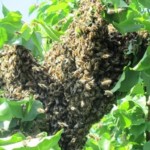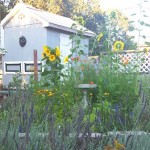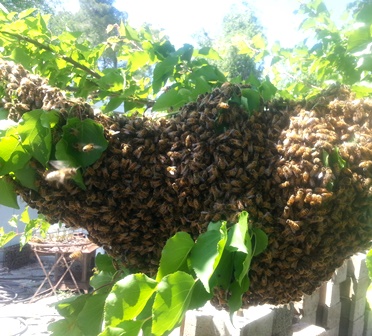Swarm in July–Does It Really Mean, “Ain’t Worth a Fly?”
Yesterday, after I’d fed and watered the chickens, I grabbed a two-gallon bucket and a ladder to pick some apricots for canning. But my morning didn’t go as planned when I spotted a cloud of bees swarming in the very fruit tree I was preparing to climb into. Nothing like a honeybee swarm to make you switch tasks in a hurry.
There’s a centuries-old saying among beekeepers: A swarm of bees in May is worth a load of hay . . . a swarm of bees in June is worth a silver spoon . . . a swarm of bees in July ain’t worth a fly. My beekeeper neighbor says simply, “A swarm in July . . . bye bye.” The rhyme echoed in my brain. Even early July? Should I try to save them? I donned my beekeeper suit and gathered together the items I would need for the rescue.
Ironically, in late winter I had hung a swarm catcher in the tree next to the swarm. A swarm catcher makes it easy to hive the bees since they are all inside the bucket-shaped unit with a small hole on one side and a large covered opening on the other. They go inside and you dump the bees into the hive box. I’ve had three swarms this year and not one of them went into the swarm catcher despite me putting attractant (a type of scented oil) in the vial inside the unit. Go figure!
Yesterday’s swarm wasn’t as big as the two I captured in May and June. I’m not even sure if I could save this one, but trying was better than losing them. I decided to help the small population along but putting into their hive some frames of comb and honey.
A swarm at this time of year (approaching the end of swarming season) will require extra food if the bees are to make it through autumn when they kick out the drones and then winter when their food and nectar sources become scarce.
I draw hope from the fact that August in the Bay Area brings blooms to certain species of eucalyptus and also star thistle. My bees also have access to lots of lavender. I have planted several types of it around my farmette.
The sunflowers in my garden are blooming now and will (thanks to consecutive planting) over the next several weeks. And I’ve got two raised beds designated as bee gardens full of blooming flowers and herbs like borage that attract bees, butterflies, and other pollinators.
It remains to be seen if this July swarm will have any worth at all. I think they’re going to need a lot of help. That means keeping my eyes on them as I take care of my chickens and keep the summer canning going.
_____________________________________________________________________________
If you enjoy reading about the workings of an urban farmette and also appreciate a good, clean mystery, check out my Henny Penny Farmette series of cozy mysteries–A BEELINE TO MURDER, THE MURDER OF A QUEEN BEE, and A HIVE OF HOMICIDES. I also write wellness and spirituality books–SACRED TRAVELS (soon to be updated to include color images), RITUALS FOR LIFE, and MY POCKET MEDITATIONS.
All my books are available at Barnes & Noble, Amazon, and other traditional and online bookstores everywhere.

More than 150 rituals for sound mind, strong body, and meaningful connections to the people around you
Lemon Oil for Luring Honeybee Swarms
Call it my sixth sense at work, but after my bees acted aggressive (which they usually are not) as I cleaned the water fountain, I prepared the swarm catcher and put it in the apricot tree nearest my office window. Mid-morning on Wednesday, I got my first swarm of 2016.
Lemon oil is often the ingredient that lures the honeybees to a swarm catcher. I mix the lemon oil mixed with water and spray the swarm catcher with a pump sprayer. It usually works better to capture the bees in the swarm catcher than having them coalesce en masse on an inconvenient limb in a tree, say, fourteen feet up.
You can use lemon oil as a salve or in the oil form–apply the salve onto the swarm catcher around the opening for the bees or use the oil in a small plastic vial that gets inserted into a swarm catcher orifice.
Bear in mind that not all lemon oils are equal. Some are more “lemony scented” than others. Lemon oil is cold pressed from the peel and contains 3 to 10 percent citral (considered the most powerful of components that contribute to the lemon scent). Lemon myrtle contains 95 percent citral and, if it’s the scent you want, lemon myrtle is superior to all others.
So, when I realized my bees were swarming, I suited up and prepared a hive box with ten frames, eight with wax from previous honey harvests (where I left the wax intact) and two that I had in the kitchen where I was draining honey from them. It would provide an immediate source of food for the bees in their new home.
Today, I visited my favorite shop for all things honeybees and stocked up on a couple more hive boxes, just in case of another swarm, although the bees are quiet and non-aggressive again.
 Facebook
Facebook Goodreads
Goodreads LinkedIn
LinkedIn Meera Lester
Meera Lester Twitter
Twitter









